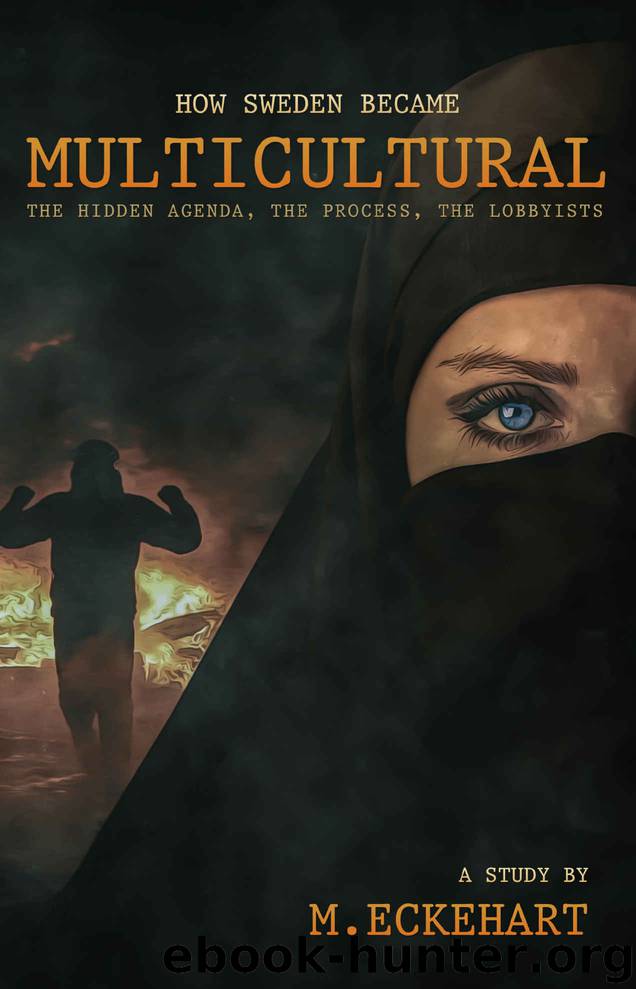How Sweden Became Multicultural by M. Eckehart

Author:M. Eckehart
Language: eng
Format: mobi, azw, epub
Publisher: TRSE Media AB
Published: 2017-09-01T07:00:00+00:00
Ethnic Dimension
The process that transformed Sweden from a homogenous nation to a multicultural one was remarkably fast. It commenced with Schwarz’s debate article in 1964 and was followed up by newspaper debates where mainly individuals from various minority groups, above all Jews, demanded that multiculturalism be implemented. Moreover Schwarz’s bill which was proposed by LO and the concerted lobbying efforts aimed at various politicians by organised ethnic minority groups, primarily Jews and Estonians, but also to some degree Finns and the Sami, had an impact.
All these factors combined resulted in the appointment of the Immigrant Investigation, which in turn based its goals on the multiculturalist arguments, mainly made by individuals from said minority groups, primarily the Jewish one, and above all David Schwarz.
Although it was never openly described as such, this process was essentially an ethnic conflict between Swedes and other ethnic groups. The minorities who demanded multiculturalism did not do so because they sought a culturally pluralistic society in Sweden. Their goal was for Swedish ethnic interests to give way to their own so that they could preserve their cultures and advance their own interests. This goal was to a large degree achieved and thus the native Swedish population ceded sovereignty over the only geographic area in the world solely dedicated to the Swedish people and Swedish culture.
The ethnologist Frank Salter, who has written comprehensively about ethnic group interests and national strategies, made the following observation:
It is in all ethnicities’ interests to promote ethnic states where they are in the majority, but discourage them where they are in the minority and distantly related to the majority ethnicity.1
In other words: a natural conflict exists between majority populations and minorities.
One countermeasure that might be used by minorities with little prospect of becoming majorities would be to prevent other ethnic groups from forming political majorities. Minority coalitions might agitate for the immigration of groups unrelated to the existing largest group, boosting the coalition’s influence at the expense of the majority.2
This corresponds well with the strategy utilized by minority activists in Sweden. That a small number of ethnic activists managed to bring about such profound changes in Swedish society contrary to ethnic Swedish interests can to a large degree be explained by the fact that the minorities were mobilised and didn’t run into any significant opposition from the Swedes.
Minorities have an advantage in ethnic competition in being more mobilized than majorities. Mobilisation is the willingness to make sacrifices for a cause, for example by donating money, time and work. Even a small group with limited resources can exercise disproportionate influence when its members are highly mobilized and its opponents, though superior in numbers and resources, are indifferent.3
The process of transforming Sweden from a culturally homogenous nation to a multicultural nation was essentially an ethnic conflict. This becomes clear if one considers the motives of those who participated in this process. The Jews who participated were the most forceful and by all accounts the most fundamental for Sweden’s transformation. It is worth considering that
Download
How Sweden Became Multicultural by M. Eckehart.azw
How Sweden Became Multicultural by M. Eckehart.epub
This site does not store any files on its server. We only index and link to content provided by other sites. Please contact the content providers to delete copyright contents if any and email us, we'll remove relevant links or contents immediately.
The Secret History by Donna Tartt(18808)
The Social Justice Warrior Handbook by Lisa De Pasquale(12126)
Thirteen Reasons Why by Jay Asher(8767)
This Is How You Lose Her by Junot Diaz(6761)
Weapons of Math Destruction by Cathy O'Neil(6116)
Zero to One by Peter Thiel(5662)
Beartown by Fredrik Backman(5575)
The Myth of the Strong Leader by Archie Brown(5404)
The Fire Next Time by James Baldwin(5224)
How Democracies Die by Steven Levitsky & Daniel Ziblatt(5112)
Promise Me, Dad by Joe Biden(5077)
Stone's Rules by Roger Stone(5013)
100 Deadly Skills by Clint Emerson(4824)
A Higher Loyalty: Truth, Lies, and Leadership by James Comey(4822)
Rise and Kill First by Ronen Bergman(4684)
Secrecy World by Jake Bernstein(4619)
The David Icke Guide to the Global Conspiracy (and how to end it) by David Icke(4606)
The Farm by Tom Rob Smith(4421)
The Doomsday Machine by Daniel Ellsberg(4397)
